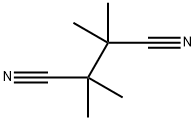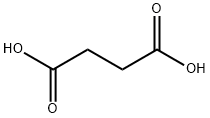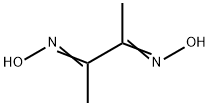Succinonitrile
Synonym(s):1,2-Dicyanoethane;Butanedinitrile
- CAS NO.:110-61-2
- Empirical Formula: C4H4N2
- Molecular Weight: 80.09
- MDL number: MFCD00001949
- EINECS: 203-783-9
- SAFETY DATA SHEET (SDS)
- Update Date: 2025-01-27 09:38:02

What is Succinonitrile?
Chemical properties
almost white to brown crystalline solid. Succinonitrile [110-61-2], ethylene dicyanide, ethylene cyanide, dicyanoethane, butanedinitrile, NCCH2CH2CN, is a colorless, waxy solid slightly soluble in water and ethanol. Succinonitrile is obtained by addition of hydrogen cyanide to acrylonitrile. Subsequent hydrogenation of succinonitrile yields 1,4-diaminobutane, which reacts with adipic acid to form the new polyamide 46. The polymer, developed by DSM (Netherlands), is marketed under the trade name Stanyl; the latter is reported to have excellent mechanical properties at high temperature.
The Uses of Succinonitrile
Succinonitrile dispersed with ionic liquids entrapped in a host polymer was used to constitute gel polymer electrolytes. It was used as dopant to investigate the ionic conductivity and X-ray absorption spectroscopic results for lithium and copper salt doped succinonitrile.
Production Methods
Succinonitrile is derived from the interaction of ethylene dibromide and potassium cyanide in the presence of alcohol.
General Description
Colorless to light brown crystals. Colorless waxy soild melting at 57°C. Highly toxic.
Air & Water Reactions
Soluble in water [Hawley].
Reactivity Profile
Succinonitrile is incompatible with acids and oxidizing agents (such as peroxides and epoxides). Can react violently with strong oxidizing acids. Is hydrolyzed exothermically in both aqueous acid and base to give carboxylic acids (or salts of carboxylic acids). Can react vigorously with reducing agents.
Hazard
A poison.
Fire Hazard
Succinonitrile is combustible.
Flammability and Explosibility
Not classified
Safety Profile
Poison by ingestion, intraperitoneal, and subcutaneous routes. An experimental teratogen. Combustible when exposed to heat or flame. Decomposes exothermically above 195°C. Can react with oxidizing materials. To fight fire, use alcohol foam, CO2, dry chemical. When heated to decomposition, or on contact with acid or acid fumes, it emits highly toxic fumes of NOx and CN-. See also NITRILES.
Purification Methods
Purify the nitrile by vacuum sublimation, and/or crystallisation from acetone. [Beilstein 2 H 615, 2 IV 1923.]
Properties of Succinonitrile
| Melting point: | 50-54 °C (lit.) |
| Boiling point: | 265-267 °C (lit.) |
| Density | 0.985 g/mL at 25 °C (lit.) |
| vapor pressure | 10.382kPa at 25.14℃ |
| refractive index | nD60 (liq) 1.41734 |
| Flash point: | >230 °F |
| storage temp. | 2-8°C |
| solubility | methanol: 0.1 g/mL, clear, colorless |
| form | Liquid |
| pka | 26.6[at 20 ℃] |
| color | Clear colorless |
| Specific Gravity | 0.985 |
| Odor | odorless |
| Water Solubility | slightly soluble |
| Merck | 14,8872 |
| BRN | 1098380 |
| Exposure limits | NIOSH: IDLH 25 mg/m3; TWA 6 ppm(20 mg/m3) |
| Dielectric constant | 58.3(58℃) |
| CAS DataBase Reference | 110-61-2(CAS DataBase Reference) |
| NIST Chemistry Reference | Succinonitrile(110-61-2) |
| EPA Substance Registry System | Butanedinitrile (110-61-2) |
Safety information for Succinonitrile
| Signal word | Warning |
| Pictogram(s) |
 Exclamation Mark Irritant GHS07  Health Hazard GHS08  Environment GHS09 |
| GHS Hazard Statements |
H302:Acute toxicity,oral H411:Hazardous to the aquatic environment, long-term hazard |
| Precautionary Statement Codes |
P202:Do not handle until all safety precautions have been read and understood. P264:Wash hands thoroughly after handling. P264:Wash skin thouroughly after handling. P270:Do not eat, drink or smoke when using this product. P273:Avoid release to the environment. P301+P312:IF SWALLOWED: call a POISON CENTER or doctor/physician IF you feel unwell. P308+P313:IF exposed or concerned: Get medical advice/attention. |
Computed Descriptors for Succinonitrile
| InChIKey | IAHFWCOBPZCAEA-UHFFFAOYSA-N |
New Products
4,4-Difluoropiperidine hydrochloride tert-butyl 9-methoxy-3-azaspiro[5.5]undecane-3-carboxylate Indole Methyl Resin N-Isopropylurea N,N-Dicyclohexylcarbodiimide(DCC) MELDRUMS ACID 5-METHYLISOXAZOLE-4-CARBOXYLIC ACID Magnessium Bis glycinate Zinc ascorbate 1-bromo-2-butyne 2-acetamidophenol 9(10H)-anthracenone Erythrosin B, 4-Piperidinopiperidine 2-((4-morpholinophenylamino) (methylthio) methylene) malononitrile 2,4-dihydroxybenzaldehyde 3-(4-morpholinophenylamino)-5-amino-1H-pyrazole-4-carbonitrile Methyl 2-methylquinoline-6-carboxylate 2,6-dichloro-4-nitropyridine 4-Bromo-2-chlorobenzonitrile 2-(benzylamino)acetic acid hydrochloride 4-(tert-Butoxycarbonylamino)but- 2-ynoic acid 3,4-dihydro-2H-benzo[b][1,4]dioxepine 1-Phenyl-1-cycloprppanecarboxylicacidRelated products of tetrahydrofuran








You may like
-
 Succinonitrile 95% CAS 110-61-2View Details
Succinonitrile 95% CAS 110-61-2View Details
110-61-2 -
 Butanedinitrile 99% (GC) CAS 110-61-2View Details
Butanedinitrile 99% (GC) CAS 110-61-2View Details
110-61-2 -
 Succinonitrile CAS 110-61-2View Details
Succinonitrile CAS 110-61-2View Details
110-61-2 -
 Succinonitrile CAS 110-61-2View Details
Succinonitrile CAS 110-61-2View Details
110-61-2 -
 Succinonitrile CAS 110-61-2View Details
Succinonitrile CAS 110-61-2View Details
110-61-2 -
 Succinonitrile CAS 110-61-2View Details
Succinonitrile CAS 110-61-2View Details
110-61-2 -
 20677-73-0 (2,2-diethoxyethyl)methylamine 98%View Details
20677-73-0 (2,2-diethoxyethyl)methylamine 98%View Details
20677-73-0 -
 3-(4-(hydroxyamino)-1-oxoisoindolin-2-yl)piperidine-2,6-dione 98%View Details
3-(4-(hydroxyamino)-1-oxoisoindolin-2-yl)piperidine-2,6-dione 98%View Details
